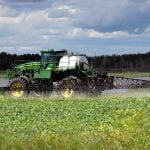Irrigation to benefit | Project intended to improve water quality for Regina and Moose Jaw, but irrigation is also likely to expand as a result
MOOSE JAW, Sask. — A proposed $1 billion water supply project from Lake Diefenbaker to Buffalo Pound Lake would generate far returns far greater than the investment, says a study delivered to the Saskatchewan government last month.
Consultant Graham Parsons said government could expect economic returns of 20 times the cost of a canal for at least 50 years, although canals last much longer than that.
“The fiscal returns to government are well above any investment a government might make in this project, well above,” he told the Saskatchewan Irrigation Projects Association conference in early December.
Read Also

No special crop fireworks expected
farmers should not expect fireworks in the special crops market due to ample supplies.
Agriculture minister Lyle Stewart said the report showed the project is feasible, but it would be up to cabinet to decide if and when to proceed.
“There’s lots to consider,” he said in an interview.
“It’s a huge project and a very expensive one as well, but it gives water security to the cities of Regina and Moose Jaw and the industrial corridor, and with lots of opportunities for expansion.”
Parsons suggested government might want to decide sooner rather than later.
“The clock is ticking and it is necessary to take decisions on water supply in this part of the world sooner rather than later,” he said in an interview.
This is not the first study to suggest the project is feasible and necessary.
The Upper Qu’Appelle Water Supply Project has been discussed for years as a way to improve water supply and quality for the two major cities south of Lake Diefenbaker.
The existing 30 kilometre man-made canal and 70 km of natural channel that moves water from one lake to the other are not in good shape.
The new conveyance would be larger and use pumping stations to move the water more efficiently through man-made canals.
It would supply the increasing needs of nearby potash mines, fertilizer plants and other industrial users, and at some point a small hydro-electric generating station could be added to capture energy from water dropping into Buffalo Pound.
It could also result in agricultural irrigation of up to 135,000 acres, according to some studies. Parsons used a minimum 110,000 acres to examine the project’s economic benefits. He said the plan when Lake Diefenbaker and the Gardiner Dam were first built was for the reservoir to be a “strong water heart” that would distribute water in all directions.
Distribution south of the lake was never fully developed.
Plans were drawn up in the 1980s that included an upland canal, but again the work wasn’t done. Various projects have been undertaken over the years to address specific concerns, such as a charcoal filtration plant.
“We’ve taken a lot of stop gap measures through the years to try to address water quality or to try and address water supply,” Parsons said.
“A canal represents a part of a solution that wouldn’t just last five years or 10 years. It’s something that’s going to last for, maybe, ever.”
After all, he said, Roman canals have lasted thousands of years and the works in southern Alberta are 100 years old.
Maintenance and rehabilitation will always be required, he added, but the large capital cost is spent only once.
“While $1 billion for a conveyance seems expensive today, I’m willing to bet that 40 years on it’ll probably be $5 billion.”
Proceeding soon fits with the province’s plan to increase agricultural exports and production by 2020.
Premier Brad Wall said last fall that Saskatchewan intends to increase crop production by 10 million tonnes, value-added activity overall and agricultural exports to $15 billion.
Expanding irrigation infrastructure is one way to achieve these targets, he said.
The establishment of the Global Institute for Food Security in Saskatoon also indicates the province will put money where its mouth is as it works to capitalize on its agricultural advantage.
PotashCorp, the province’s major partner in the project, represents an industry that also needs a secure water supply.
“I really do think that the conveyance is one of the items that secures not only a water supply but really starts to consolidate Saskatchewan’s new role in the world of fertilizers and food,” Parsons said.
The world population is rising, climate is warming and food production will change as a result.
Parsons said irrigation secures crop supply and value-added prospects for feedlots, packing plants, greenhouses and other businesses.
“The benefits are very real and we see those benefits in a practical sense for anybody who has ever driven from Medicine Hat down to Leth-bridge, because that country was the same country that Palliser said nobody should live in,” he said.
“It has by far the worst drought record of anywhere on the Prairies and yet it’s one of the richest agricultural areas in the Prairies these days in terms of both the value to farmers and in terms of the related economic activity that has been built around that secure crop supply, and it’s all based on irrigation.”














